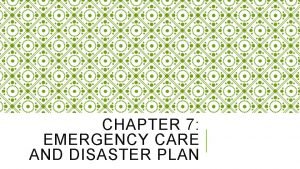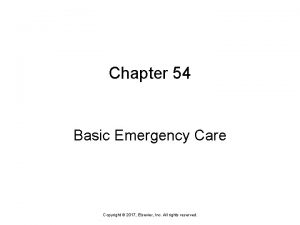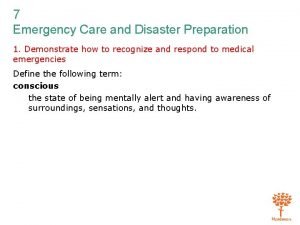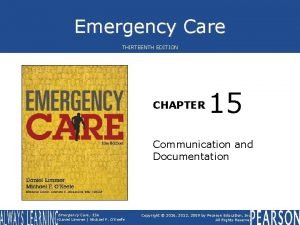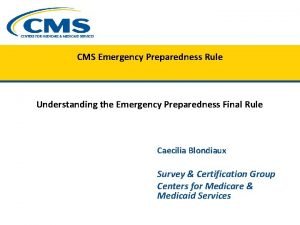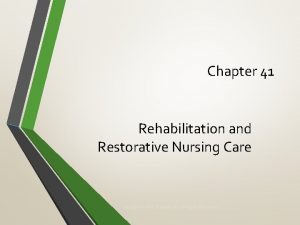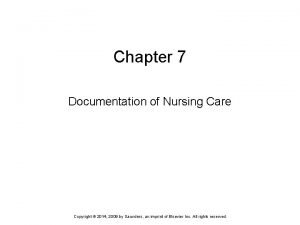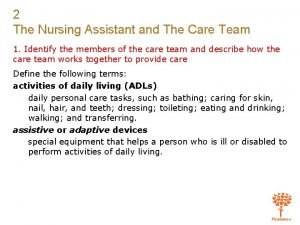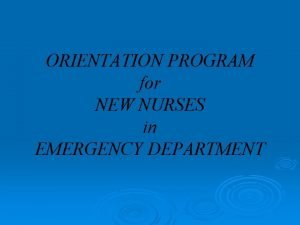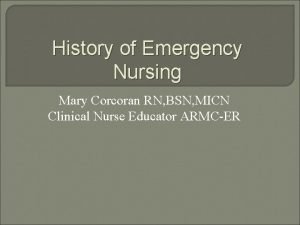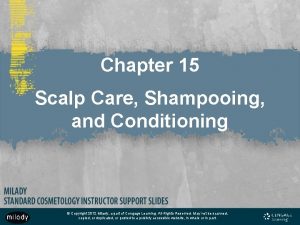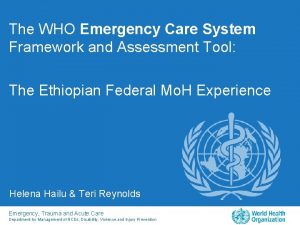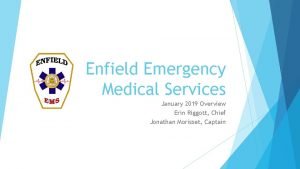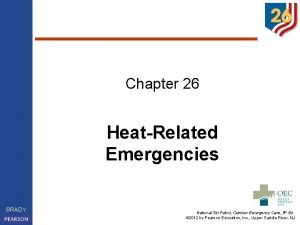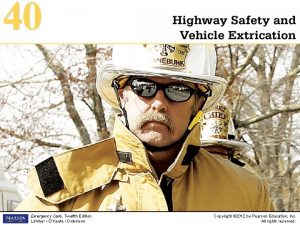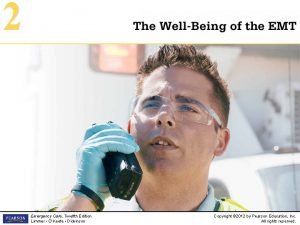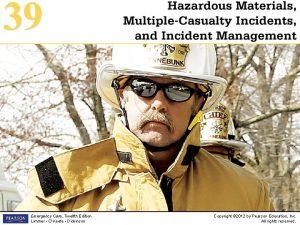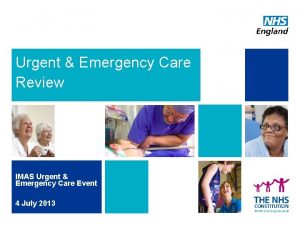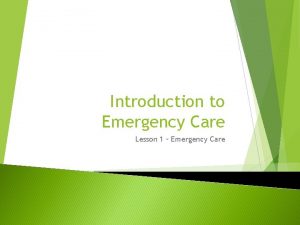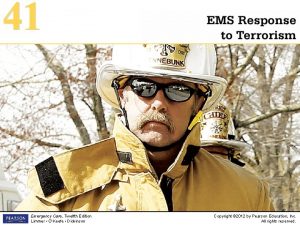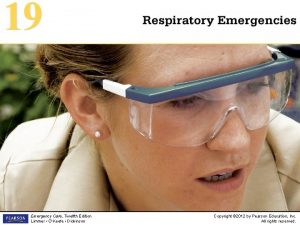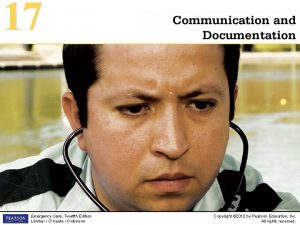Chapter 33 Emergency Nursing Emergency Care Area Requirements































- Slides: 31

Chapter 33 Emergency Nursing

Emergency Care Area Requirements Central Easy location access Dedicated Basic “crash table” necessary equipment Oxygen source Suction unit Surgical lighting Multiple electrical outlets 2

Crash Cart Organize and prioritize drawers according to the ABC’s A=airway B=breathing Thoracocentesis Venous materials for emergency respiratory patient access (C=circulation) Venous access drawer Various sizes and lengths catheters 3

4

Emergency Drugs Well organized and labeled Current dose chart Syringes and saline flush nearby 5

Laboratory Equipment Minimum Lactate database “QATS” testing Additional Blood testing gases Coagulation Commercial Ethylene testing test kits glycol 6

Fluid Therapy Goals and objectives Maintaining hydration Replacing fluid losses Treatment of shock Treatment of hypoproteinemia Increase urine output Correcting Providing acid–base or electrolyte disturbances nutritional support 7

Fluid Therapy in Shock To correct poor perfusion, replace deficits rapidly Goal: expand maintain the intravascular space Shock fluid rates Combination of therapy crystalloids and colloids 8

Principles of Triage Set protocols for a consistent, thorough response CRASH Be PLAN well-organized Expect the unexpected 9

Cardiopulmonary Arrest Cessation of breathing and effective blood circulation 10

Cardiopulmonary Arrest Complication Potential of any critical illness complication in healthy patients undergoing anesthesia 11

Definitions CPR 12 = Cardiopulmonary Resuscitation Providing ventilation and assisted circulation CPCR = Cardiopulmonary Cerebral Resuscitation Acronym emphasizes the importance of maintaining perfusion and oxygen delivery to the central nervous system during and after an arrest

Patients at Risk For an Arrest Respiratory Heart difficulty disease Severe hypothermia Multi-organ Trauma Shock failure 13

Patients at Risk for an Arrest Anesthetized Monitor patients for unexplained changes in anesthetic depth Frequently monitor vital signs during entire procedure Monitor closely after anesthesia Support perfusion with fluids, heating pads 14

Vagal Arrest Caused by heightened vagus nerve stimulation or vagal tone Common diseases associated with vagal arrests Gastrointestinal Respiratory disease Neurological Ophthalmic disease 15

CPCR Protocols First step: Call for help! 16

CPCR Protocols Second step: Basic life support Airway Breathing Circulation Current protocols may advocate the “CABs” to reflect the importance of restoring perfusion during the resuscitation efforts. 17

CPCR Protocols A = Airway If respirations are absent or weak, the mouth should be opened and examined for possible obstruction 18

CPCR Protocols B = Breathing If the animal does not begin to breathe, the patient must receive ventilation assistance Mouth-to-nose resuscitation may be performed by sealing the lip margins and blowing into the animal’s nose Neonates may be intubated with a small red rubber catheter; oxygen can be delivered carefully by blowing through the tube 19

An endotracheal tube connected to an Ambu bag and oxygen source provides an ideal means to supply 100% oxygen and manual assisted ventilation.

CPCR Protocols B = Breathing Visualize airway with laryngoscope Pull tongue forward with dry gauze to facilitate tube passage Suction Stylets readily available 21

CPCR Protocols B 22 = Breathing Begin ventilation First two breaths administered should be long breaths lasting a full 2 seconds followed by patient assessment If voluntary breathing is not immediate, manually ventilate

CPCR Protocols Ventilation Manually ventilated at a rate slightly higher than the expected normal Goal: expand the chest by 30% with a slightly longer expiration than inspiration Inspiratory Pressures 20 cm H 2 O dog 15 cm H 2 O cat 23

CPCR Protocols Failed respiratory resuscitation may respond to acupuncture to labial fulcrum Insert 25 g needle 1. 0 mm and twist 24

CPCR Protocols C = Circulation Once the airway is established and ventilation provided, assess circulation Palpation of pulses (or apex heart beat) Auscultation of the heart 25

CPCR Protocols Once cardiac arrest has been confirmed, initiate chest compressions Positioning Depends Shape The of animal on the animal’s size of the chest (barrel chest vs. deep and narrow chest) caregiver’s ability to deliver adequate compressions 26

CPCR Protocols Place palm over heart; hand-over-hand Compress Place with elbows and weight of body stack of towels under patient’s heart Small dogs or cats may place sternal and compress ventrally “Tennis-ball” technique 27


CPCR Protocols Allow time between compressions for adequate ventricular filling Intermittent Alternate abdominal compression with external chest compression 29

CPCR Effectiveness 30 of CPCR Assessed by palpating for a pulse and evaluating mucous membrane color Use ECG if available Use ultrasound if available to assess the heart

Open-Chest CPCR Indicated in animals with chest trauma Open-chest CPCR is only beneficial if initiated early in the resuscitation effort Open-chest CPCR should be made within 2 minutes of cardiopulmonary arrest 31
 Nursing care plan of obsessive compulsive disorder
Nursing care plan of obsessive compulsive disorder Nursing care plan of cataract
Nursing care plan of cataract Levels of health care primary secondary tertiary
Levels of health care primary secondary tertiary Emergency care and disaster preparation chapter 7
Emergency care and disaster preparation chapter 7 Chapter 54 basic emergency care
Chapter 54 basic emergency care Emergency care first aid and disasters
Emergency care first aid and disasters Emergency care and disaster preparation
Emergency care and disaster preparation Prehospital emergency care 11th edition
Prehospital emergency care 11th edition Emergency care 13th edition chapter 1
Emergency care 13th edition chapter 1 Cms emergency preparedness final rule
Cms emergency preparedness final rule Chapter 41 rehabilitation and restorative nursing care
Chapter 41 rehabilitation and restorative nursing care Documenting nursing notes examples
Documenting nursing notes examples 5 rights of delegation nursing examples
5 rights of delegation nursing examples Chapter 2 the nursing assistant and the care team
Chapter 2 the nursing assistant and the care team Moraine valley nursing
Moraine valley nursing Lone star nursing
Lone star nursing Glendale nursing
Glendale nursing School of nursing ubc
School of nursing ubc Mark covin
Mark covin Gcc nursing program
Gcc nursing program Lonestar nursing requirements
Lonestar nursing requirements Emergency department nursing orientation manual
Emergency department nursing orientation manual History of emergency nursing
History of emergency nursing Chemical shampoo
Chemical shampoo Adjusted body weight formula dietitian
Adjusted body weight formula dietitian Scalp care shampooing and conditioning
Scalp care shampooing and conditioning Who emergency care system framework
Who emergency care system framework Prehospital emergency care 10th edition
Prehospital emergency care 10th edition Pre-hospital communication
Pre-hospital communication Injuries first aid
Injuries first aid Emergency care enfield
Emergency care enfield Outdoor emergency care 6th edition
Outdoor emergency care 6th edition



